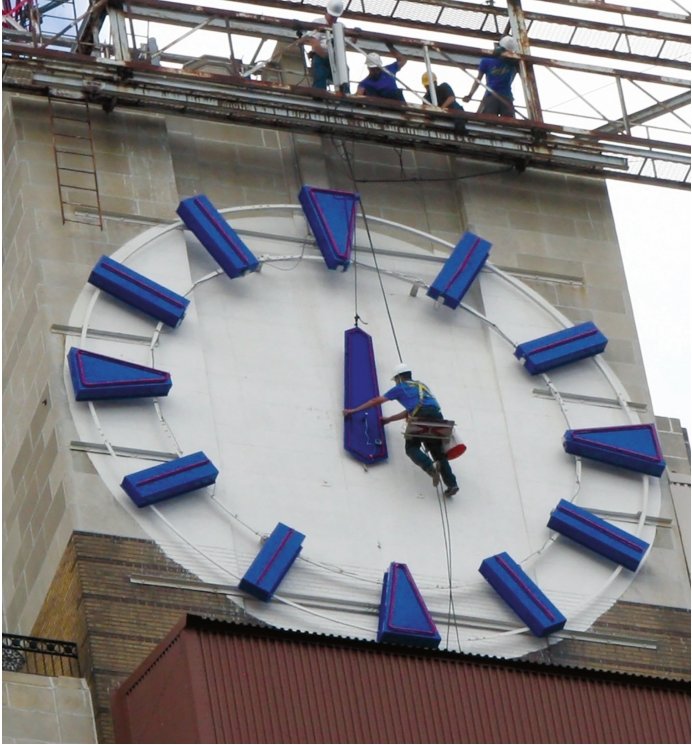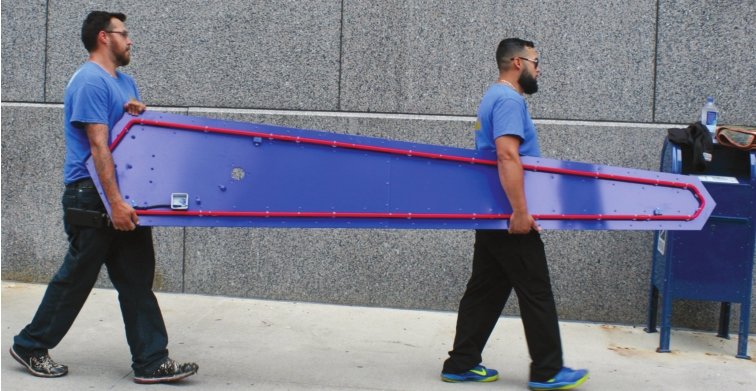 Boji Tower clock gets a new pair of hands
Boji Tower clock gets a new pair of hands “Let’s go, let’s go,” Larry Willerson yelled from a catwalk near the top of Lansing’s tallest building. “It’s a good thing you don’t drive an ambulance. Everybody would be dead.”
Below the catwalk, visible under Willerson’s angry-looking alligator boots, dangled two things that needed to come together fast: employee Jakki “Jake & Bake” Herrick and the Boji Tower clock’s new minute hand.
For a few crucial seconds Friday morning, the shiny blue, 10-foot-long aluminum plate lined with red LED lights was liable to catch the slightest breeze swirling 280 feet above the streets of Lansing, like a sail, and slam into a wall.
Herrick swung to his right and grabbed the sleek slab. He peeled off its padded protective sleeve and hesitated for a second.
“Just drop it, drop it,” Willerson shouted, knowing a metal awning would stop the sleeve from plummeting to the street.
In less than a minute, Herrick set to work bolting the hand to the 25-foot-wide clock face.
On a clear day you can see 22 miles from the top of the tower, all the way to St. Johns.
“Just another day for me,” Herrick said after being hoisted back to the parapet. “I love this job.”
The big clock should be set for quite a while.
The bright LED lights, wrapped in plastic tubes, won’t be as fragile as the old neon tubes. The aluminum will resist rust. The new mechanism was made by Swiss clock maker Mobatime, maker of the rail station and airport clocks in the world’s most notoriously precision-mad nation.
The Grand Rapids-based Lumichron Tower Clock Co. handled the renovation. Willerson and his crew at Sky High, the go-to daredevils for any work needed on the Boji Tower, did the wrangling.
The clock is synchronized to the second, using GPS. There will be no need to reset the hands for daylight savings time. If it stops for any reason, the clock will know what time to reset.
This summer’s renovation cost $90,000 — 60 times the clock’s original $1,500 price tag when work began on the face, in December 1934.
At 25 feet across, the Boji clock is the eighth largest in the United States and about as big as they come in the world, Lumichron CEO Ian Macartney said. (The clock face at Big Ben in London is only 23 feet across.)
“There is certainly nothing on this scale in Grand Rapids,” he said.
Macartney found the Boji clock to be strikingly modern for its time, both in material and design.
“Neon was introduced to this country in 1928,” Macartney said. “It was brand new technology.”
The wedge-shaped, 16-inch-wide indexes marking the hours herald the Art Deco look that replaced old-fashioned Roman numerals in the 1930s.
Corrosion, rust and brutal weather started attacking the old steel hands as soon as the clock lit up for the first time on Jan. 15, 1935, when the Boji Tower was known as the Olds Tower.
The hands were first removed, repaired and returned to the clock in March 1935, only a few weeks later.
In February 1949, ice jammed the mechanism and the hands came down again. The company that made the original parts, National Time, was already out of business and the owners had to scramble for repairs.
But the new parts had defective brushes that conked out between 6:30 and 9:30, so the hands came off yet again.
A grumbling Olds Tower building manager considered replacing the neon with spotlights and reflective tape, but by then the clock was already an untouchable civic icon.
The hands came down most recently in March 2017, after persistent sticking and a general deterioration brought matters to a head.
Macartney’s team started fabricating new components for a 21st-century makeover in June. The new hands are ribbed for strength, with counterweights of brass at one end for balance.
“It’s a little like an airplane wing,” Macartney said. “You have to allow for a little flex, but not too much.”
Thursday morning, the day before installation, Willerson, Macartney and two assistants carried the new hands up four flights of rickety fire stairs wedged between the tower and the Hollister Building next door, dodging pigeon droppings and broken glass.
They could have used ropes from ground level, but the less time the hands spend in the air, Willerson said, the better.
“Feel that breeze?” he said, standing at street level. With his western boots and polite drawl, he resembles the Slim Pickens character in “Dr. Strangelove.”
“You can compare these hands to feathers,” he said. “Up there, that wind can push these things back and forth, smash a window or kill somebody. There’s a thousand things to think about.”
Thursday, after delivering the hands to Willerson, Macartney was off to a three-clock job at James Madison University. He loves the clock tower business. He started out selling neon clocks for room use, but Chinese manufacturers stole the design and sold them for a 10th of the price. He has no such problems now.
“There is no inventory and every job is made to order,” he said.
He also loves analog clock faces. “They’re comforting,” he said. “All it takes is a glance and you know how much time you have.”
Support City Pulse - Donate Today!
Comments
No comments on this item Please log in to comment by clicking here